Fitzgerald A.E. Electric Machinery
Подождите немного. Документ загружается.

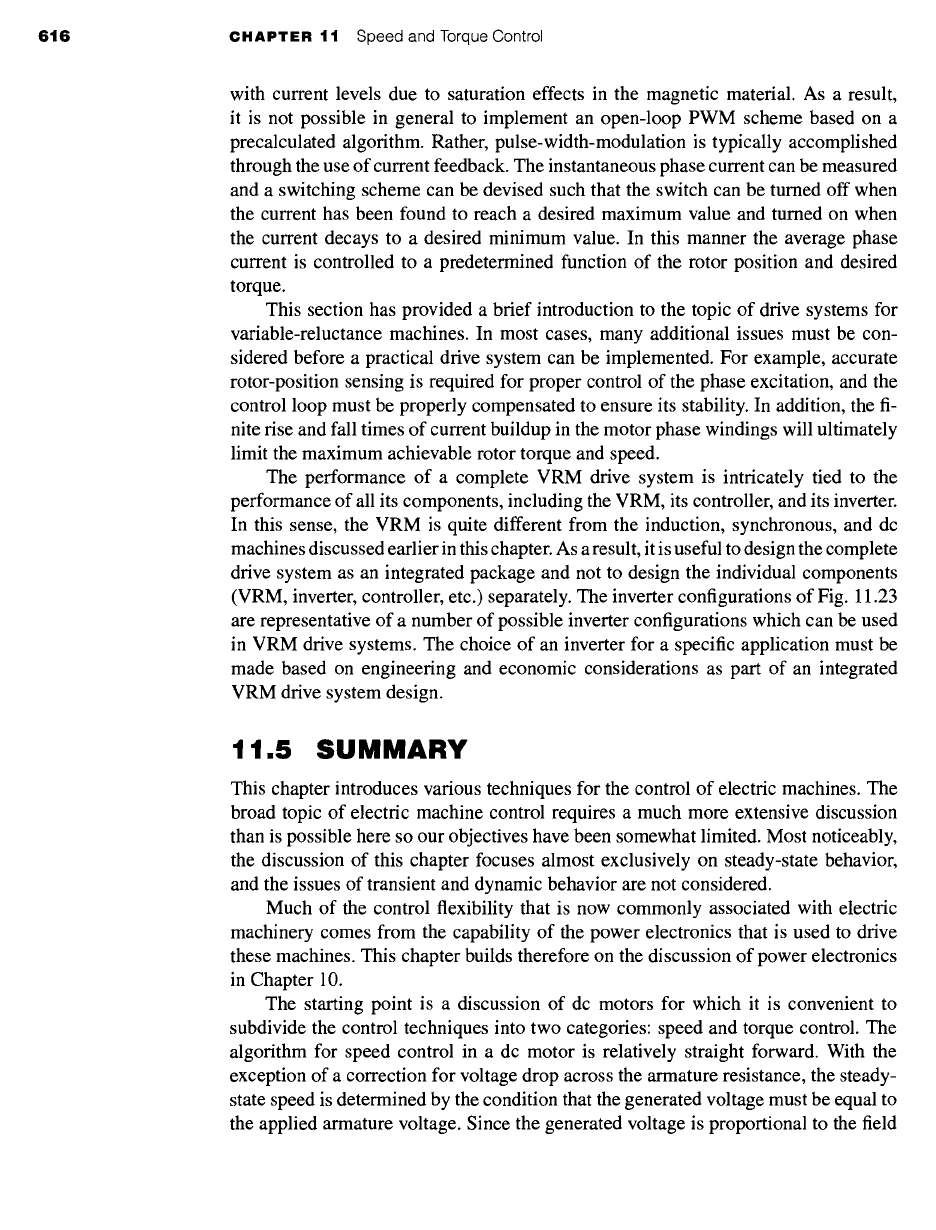
616 CHAPTER 11 Speed and Torque Control
with current levels due to saturation effects in the magnetic material. As a result,
it is not possible in general to implement an open-loop PWM scheme based on a
precalculated algorithm. Rather, pulse-width-modulation is typically accomplished
through the use of current feedback. The instantaneous phase current can be measured
and a switching scheme can be devised such that the switch can be turned off when
the current has been found to reach a desired maximum value and turned on when
the current decays to a desired minimum value. In this manner the average phase
current is controlled to a predetermined function of the rotor position and desired
torque.
This section has provided a brief introduction to the topic of drive systems for
variable-reluctance machines. In most cases, many additional issues must be con-
sidered before a practical drive system can be implemented. For example, accurate
rotor-position sensing is required for proper control of the phase excitation, and the
control loop must be properly compensated to ensure its stability. In addition, the fi-
nite rise and fall times of current buildup in the motor phase windings will ultimately
limit the maximum achievable rotor torque and speed.
The performance of a complete VRM drive system is intricately tied to the
performance of all its components, including the VRM, its controller, and its inverter.
In this sense, the VRM is quite different from the induction, synchronous, and dc
machines discussed earlier in this chapter. As a result, it is useful to design the complete
drive system as an integrated package and not to design the individual components
(VRM, inverter, controller, etc.) separately. The inverter configurations of Fig. 11.23
are representative of a number of possible inverter configurations which can be used
in VRM drive systems. The choice of an inverter for a specific application must be
made based on engineering and economic considerations as part of an integrated
VRM drive system design.
11.5 SUMMARY
This chapter introduces various techniques for the control of electric machines. The
broad topic of electric machine control requires a much more extensive discussion
than is possible here so our objectives have been somewhat limited. Most noticeably,
the discussion of this chapter focuses almost exclusively on steady-state behavior,
and the issues of transient and dynamic behavior are not considered.
Much of the control flexibility that is now commonly associated with electric
machinery comes from the capability of the power electronics that is used to drive
these machines. This chapter builds therefore on the discussion of power electronics
in Chapter 10.
The starting point is a discussion of dc motors for which it is convenient to
subdivide the control techniques into two categories: speed and torque control. The
algorithm for speed control in a dc motor is relatively straight forward. With the
exception of a correction for voltage drop across the armature resistance, the steady-
state speed is determined by the condition that the generated voltage must be equal to
the applied armature voltage. Since the generated voltage is proportional to the field
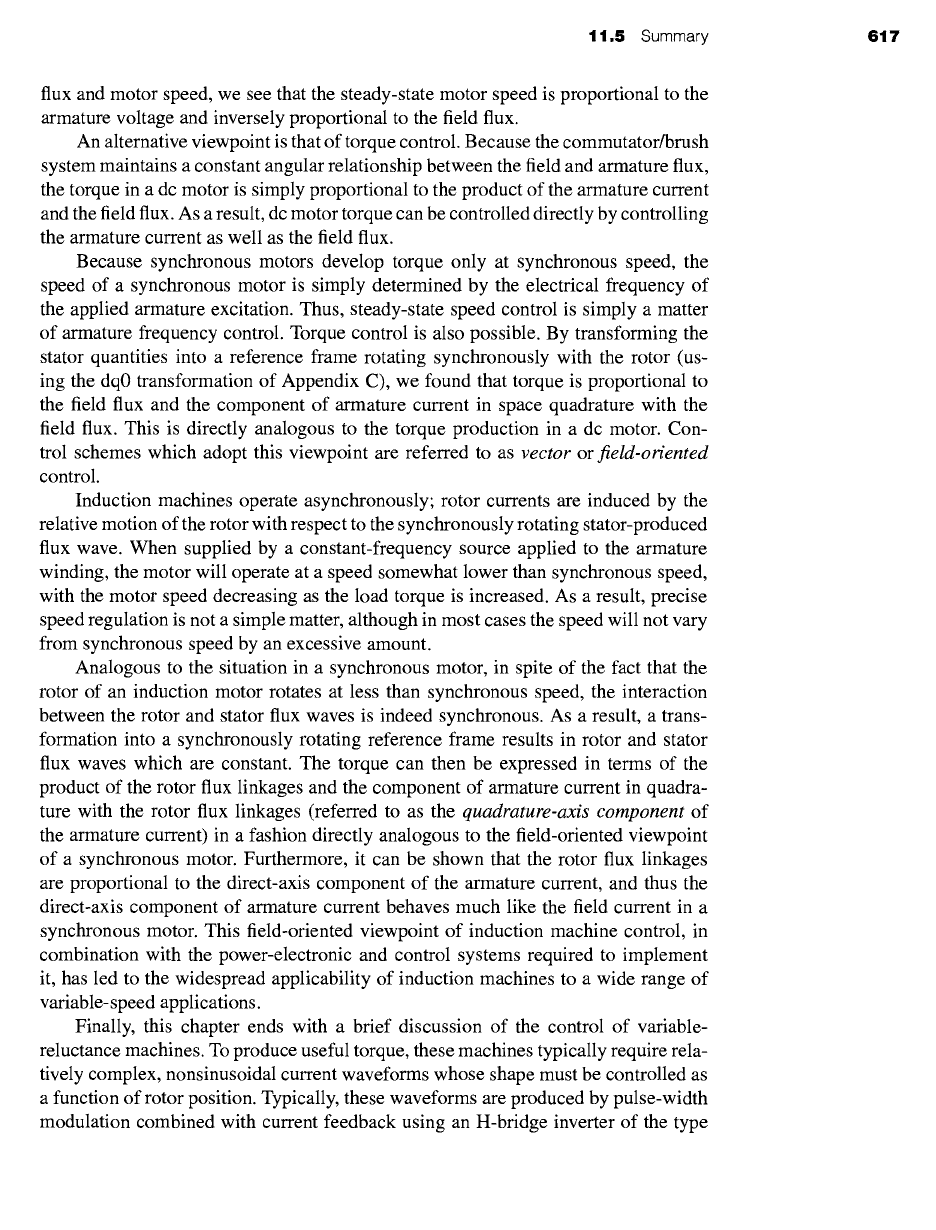
11.5 Summary 617
flux and motor speed, we see that the steady-state motor speed is proportional to the
armature voltage and inversely proportional to the field flux.
An alternative viewpoint is that of torque control. Because the commutator/brush
system maintains a constant angular relationship between the field and armature flux,
the torque in a dc motor is simply proportional to the product of the armature current
and the field flux. As a result, dc motor torque can be controlled directly by controlling
the armature current as well as the field flux.
Because synchronous motors develop torque only at synchronous speed, the
speed of a synchronous motor is simply determined by the electrical frequency of
the applied armature excitation. Thus, steady-state speed control is simply a matter
of armature frequency control. Torque control is also possible. By transforming the
stator quantities into a reference frame rotating synchronously with the rotor (us-
ing the dq0 transformation of Appendix C), we found that torque is proportional to
the field flux and the component of armature current in space quadrature with the
field flux. This is directly analogous to the torque production in a dc motor. Con-
trol schemes which adopt this viewpoint are referred to as
vector
or
field-oriented
control.
Induction machines operate asynchronously; rotor currents are induced by the
relative motion of the rotor with respect to the synchronously rotating stator-produced
flux wave. When supplied by a constant-frequency source applied to the armature
winding, the motor will operate at a speed somewhat lower than synchronous speed,
with the motor speed decreasing as the load torque is increased. As a result, precise
speed regulation is not a simple matter, although in most cases the speed will not vary
from synchronous speed by an excessive amount.
Analogous to the situation in a synchronous motor, in spite of the fact that the
rotor of an induction motor rotates at less than synchronous speed, the interaction
between the rotor and stator flux waves is indeed synchronous. As a result, a trans-
formation into a synchronously rotating reference frame results in rotor and stator
flux waves which are constant. The torque can then be expressed in terms of the
product of the rotor flux linkages and the component of armature current in quadra-
ture with the rotor flux linkages (referred to as the
quadrature-axis component
of
the armature current) in a fashion directly analogous to the field-oriented viewpoint
of a synchronous motor. Furthermore, it can be shown that the rotor flux linkages
are proportional to the direct-axis component of the armature current, and thus the
direct-axis component of armature current behaves much like the field current in a
synchronous motor. This field-oriented viewpoint of induction machine control, in
combination with the power-electronic and control systems required to implement
it, has led to the widespread applicability of induction machines to a wide range of
variable-speed applications.
Finally, this chapter ends with a brief discussion of the control of variable-
reluctance machines. To produce useful torque, these machines typically require rela-
tively complex, nonsinusoidal current waveforms whose shape must be controlled as
a function of rotor position. Typically, these waveforms are produced by pulse-width
modulation combined with current feedback using an H-bridge inverter of the type
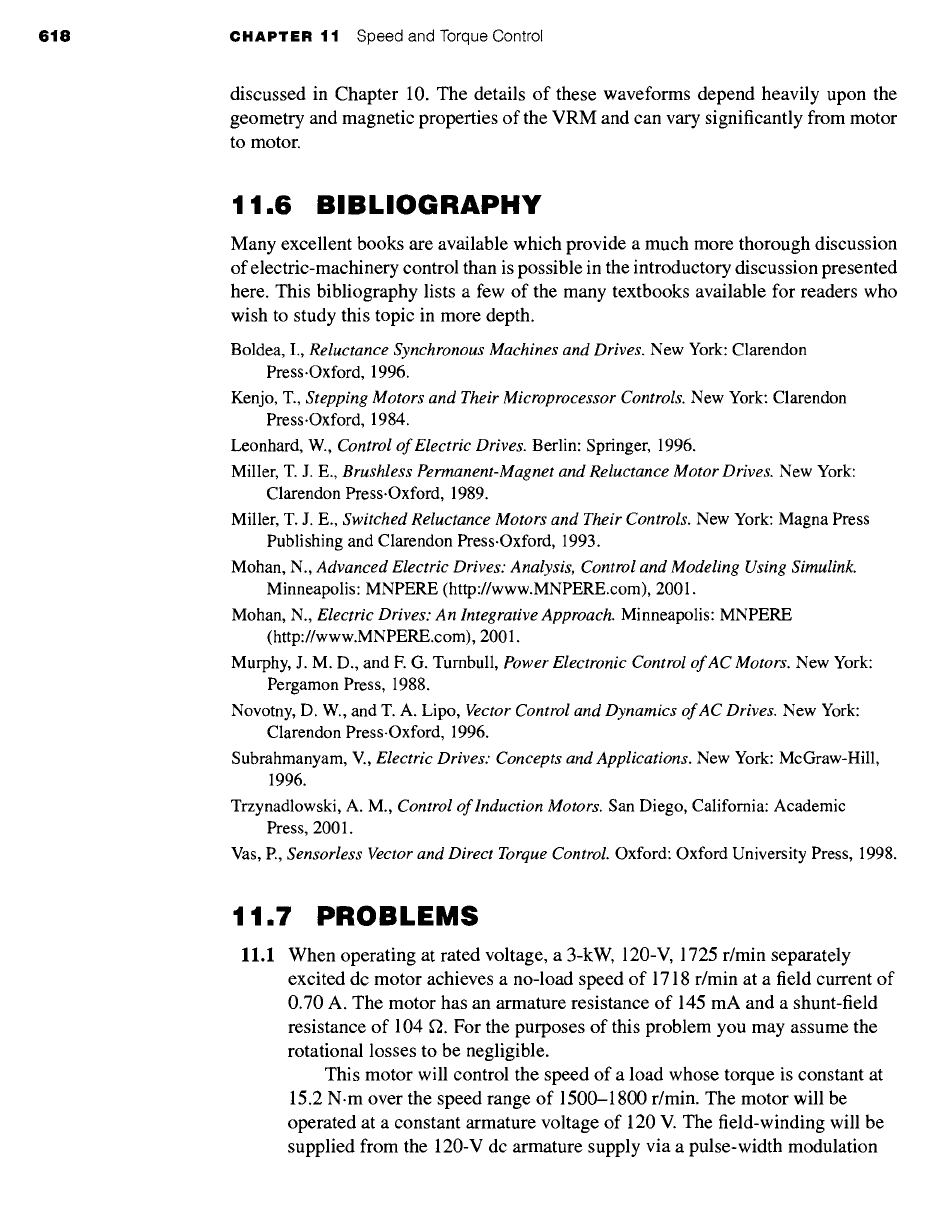
618 CHAPTER 11 Speed and Torque Control
discussed in Chapter 10. The details of these waveforms depend heavily upon the
geometry and magnetic properties of the VRM and can vary significantly from motor
to motor.
11.6 BIBLIOGRAPHY
Many excellent books are available which provide a much more thorough discussion
of electric-machinery control than is possible in the introductory discussion presented
here. This bibliography lists a few of the many textbooks available for readers who
wish to study this topic in more depth.
Boldea, I., Reluctance Synchronous Machines and Drives. New York: Clarendon
Press.Oxford, 1996.
Kenjo, T., Stepping Motors and Their Microprocessor Controls. New York: Clarendon
Press.Oxford, 1984.
Leonhard, W., Control of Electric Drives. Berlin: Springer, 1996.
Miller, T. J. E., Brushless Permanent-Magnet and Reluctance Motor Drives. New York:
Clarendon Press.Oxford, 1989.
Miller, T. J. E., Switched Reluctance Motors and Their Controls. New York: Magna Press
Publishing and Clarendon Press.Oxford, 1993.
Mohan, N., Advanced Electric Drives: Analysis, Control and Modeling Using Simulink.
Minneapolis: MNPERE (http://www.MNPERE.com), 2001.
Mohan, N., Electric Drives: An Integrative Approach. Minneapolis: MNPERE
(http://www.MNPERE.com), 2001.
Murphy, J. M. D., and E G. Turnbull, Power Electronic Control of AC Motors. New York:
Pergamon Press, 1988.
Novotny, D. W., and T. A. Lipo, Vector Control and Dynamics of AC Drives. New York:
Clarendon Press.Oxford, 1996.
Subrahmanyam, V., Electric Drives: Concepts and Applications. New York: McGraw-Hill,
1996.
Trzynadlowski, A. M., Control of Induction Motors. San Diego, California: Academic
Press, 2001.
Vas, E, Sensorless Vector and Direct Torque Control. Oxford: Oxford University Press, 1998.
11.7 PROBLEMS
11.1 When operating at rated voltage, a 3-kW, 120-V, 1725 r/min separately
excited dc motor achieves a no-load speed of 1718 r/min at a field current of
0.70 A. The motor has an armature resistance of 145 mA and a shunt-field
resistance of 104 f2. For the purposes of this problem you may assume the
rotational losses to be negligible.
This motor will control the speed of a load whose torque is constant at
15.2 N.m over the speed range of 1500-1800 r/min. The motor will be
operated at a constant armature voltage of 120 V. The field-winding will be
supplied from the 120-V dc armature supply via a pulse-width modulation
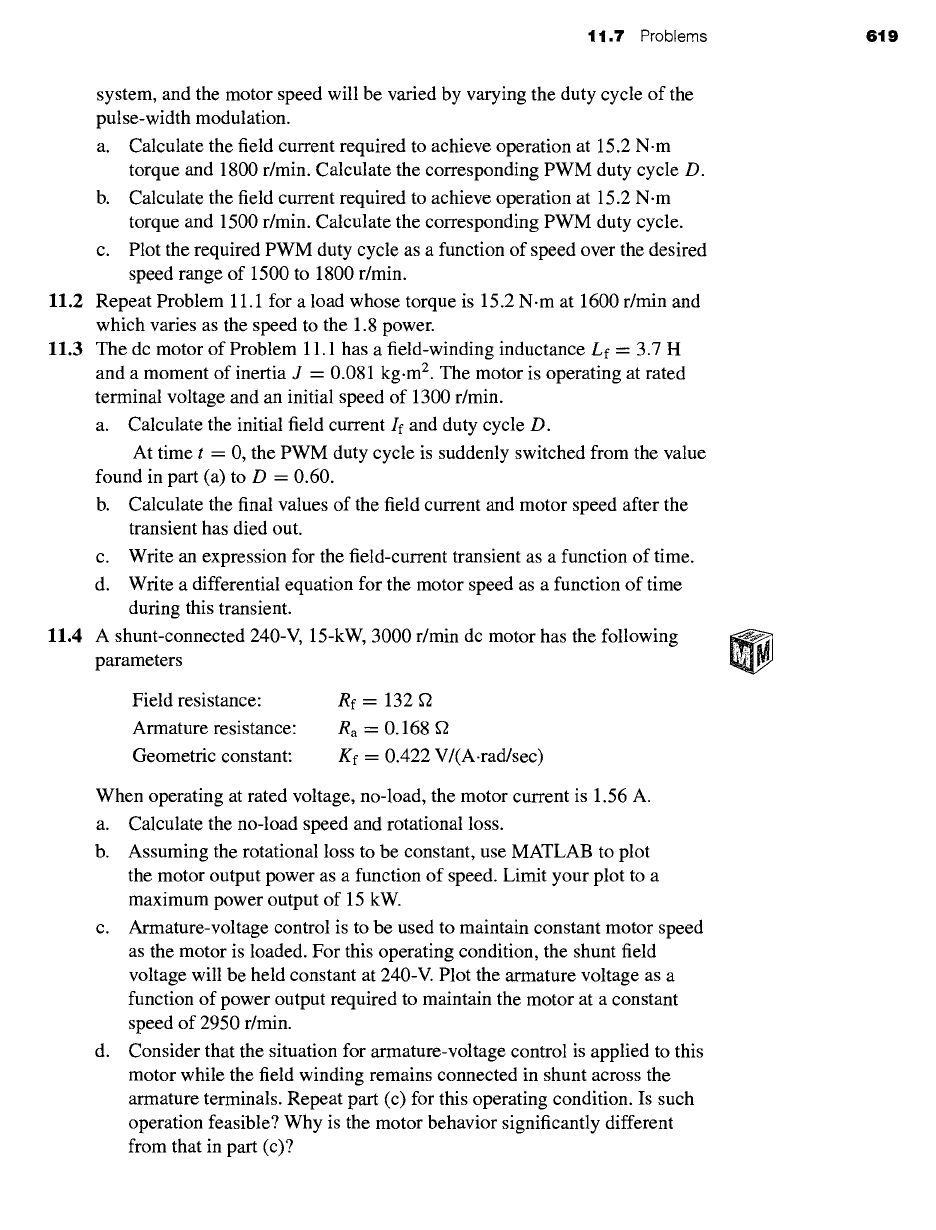
11.7 Problems 619
system, and the motor speed will be varied by varying the duty cycle of the
pulse-width modulation.
a. Calculate the field current required to achieve operation at 15.2 N.m
torque and 1800 r/min. Calculate the corresponding PWM duty cycle D.
b. Calculate the field current required to achieve operation at 15.2 N.m
torque and 1500 r/min. Calculate the corresponding PWM duty cycle.
c. Plot the required PWM duty cycle as a function of speed over the desired
speed range of 1500 to 1800 r/min.
11.2 Repeat Problem 11.1 for a load whose torque is 15.2 N.m at 1600 r/min and
which varies as the speed to the 1.8 power.
11.3 The dc motor of Problem 11.1 has a field-winding inductance Lf -- 3.7 H
and a moment of inertia J = 0.081 kg.m 2. The motor is operating at rated
terminal voltage and an initial speed of 1300 r/min.
a. Calculate the initial field current If and duty cycle D.
At time t = 0, the PWM duty cycle is suddenly switched from the value
found in part (a) to D = 0.60.
b. Calculate the final values of the field current and motor speed after the
transient has died out.
c. Write an expression for the field-current transient as a function of time.
d. Write a differential equation for the motor speed as a function of time
during this transient.
11.4 A shunt-connected 240-V, 15-kW, 3000 r/min dc motor has the following
parameters
Field resistance:
Armature resistance:
Geometric constant:
Rf = 132 g2
Ra -- 0.168 f2
Kf = 0.422 V/(A.rad/sec)
When operating at rated voltage, no-load, the motor current is 1.56 A.
a. Calculate the no-load speed and rotational loss.
b. Assuming the rotational loss to be constant, use MATLAB to plot
the motor output power as a function of speed. Limit your plot to a
maximum power output of 15 kW.
c. Armature-voltage control is to be used to maintain constant motor speed
as the motor is loaded. For this operating condition, the shunt field
voltage will be held constant at 240-V. Plot the armature voltage as a
function of power output required to maintain the motor at a constant
speed of 2950 r/min.
d. Consider that the situation for armature-voltage control is applied to this
motor while the field winding remains connected in shunt across the
armature terminals. Repeat part (c) for this operating condition. Is such
operation feasible? Why is the motor behavior significantly different
from that in part (c)?

620 CHAPTER
11 Speed and Torque Control
11.5 The data sheet for a small permanent-magnet dc motor provides the
following parameters"
Rated voltage:
Rated output power:
No-load speed:
Torque constant:
Stall torque:
grated -~-
3 V
Prated = 0.28 W
nnl =
12,400 r/min
Km = 0.218 mV/(r/min)
Tstall --
0.094 oz.in
a. Calculate the motor armature resistance.
b. Calculate the no-load rotational loss.
c. Assume the motor to be connected to a load such that the total shaft
power (actual load plus rotational loss) is equal 0.25 W at a speed of
12,000 r/min. Assuming this load to vary as the square of the motor
speed, write a MATLAB script to plot the motor speed as a function of
terminal voltage for 1.0 V < Va < 3.0 V.
11.6 The data sheet for a 350-W permanent-magnet dc motor provides the
following parameters:
Rated voltage:
Armature resistance:
No-load speed:
No-load current:
Vrated -- 24 V
Ra --- 97 mf2
nnl = 3580 r/min
/a,nl =
0.47 A
a. Calculate the motor torque-constant Km in V/(rad/sec).
b. Calculate the no-load rotational loss.
c. The motor is supplied from a 30-V dc supply through a PWM inverter.
Table 11.1 gives the measured motor current as a function of the PWM
duty cycle D.
Complete the table by calculating the motor speed and the load power for
each value of D. Assume that the rotational losses vary as the square of the
motor speed.
Table 11.1
Motor-performance data
for Problem 11.6.
nil
i i
D I, (A) r/min PIo.d (W)
0.80 13.35
0.75 12.70
0.70 12.05
0.65 11.40
0.60 10.70
0.55 10.05
0.50 9.30
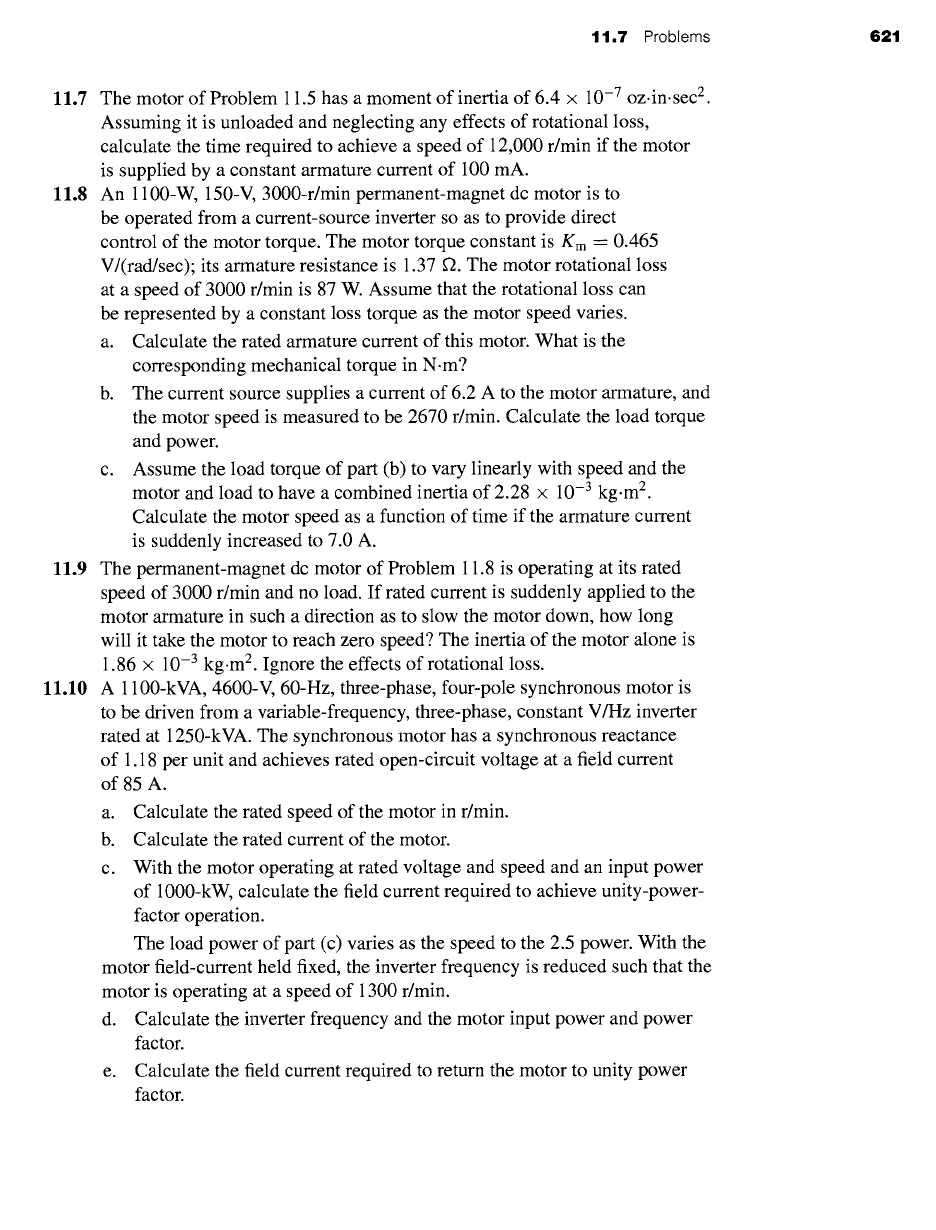
11.7 Problems
621
11.7 The motor of Problem 11.5 has a moment of inertia of 6.4 x 10 -7 oz.in.sec 2.
Assuming it is unloaded and neglecting any effects of rotational loss,
calculate the time required to achieve a speed of 12,000 r/min if the motor
is supplied by a constant armature current of 100 mA.
11.8 An 1100-W,
150-V, 3000-r/min permanent-magnet dc motor is to
be operated from a current-source inverter so as to provide direct
control of the motor torque. The motor torque constant is Km -- 0.465
V/(rad/sec); its armature resistance is 1.37 f2. The motor rotational loss
at a speed of 3000 r/min is 87 W. Assume that the rotational loss can
be represented by a constant loss torque as the motor speed varies.
a. Calculate the rated armature current of this motor. What is the
corresponding mechanical torque in N.m?
b. The current source supplies a current of 6.2 A to the motor armature, and
the motor speed is measured to be 2670 r/min. Calculate the load torque
and power.
c. Assume the load torque of part (b) to vary linearly with speed and the
motor and load to have a combined inertia of 2.28 x 10 -3 kg.m 2.
Calculate the motor speed as a function of time if the armature current
is suddenly increased to 7.0 A.
11.9 The permanent-magnet dc motor of Problem 11.8 is operating at its rated
speed of 3000 r/min and no load. If rated current is suddenly applied to the
motor armature in such a direction as to slow the motor down, how long
will it take the motor to reach zero speed? The inertia of the motor alone is
1.86 x 10 -3 kg-m 2. Ignore the effects of rotational loss.
11.10 A 1100-kVA, 4600-V, 60-Hz, three-phase, four-pole synchronous motor is
to be driven from a variable-frequency, three-phase, constant V/Hz inverter
rated at 1250-kVA. The synchronous motor has a synchronous reactance
of 1.18 per unit and achieves rated open-circuit voltage at a field current
of 85 A.
a. Calculate the rated speed of the motor in r/min.
b. Calculate the rated current of the motor.
c. With the motor operating at rated voltage and speed and an input power
of 1000-kW, calculate the field current required to achieve unity-power-
factor operation.
The load power of part (c) varies as the speed to the 2.5 power. With the
motor field-current held fixed, the inverter frequency is reduced such that the
motor is operating at a speed of 1300 r/min.
d. Calculate the inverter frequency and the motor input power and power
factor.
e. Calculate the field current required to return the motor to unity power
factor.
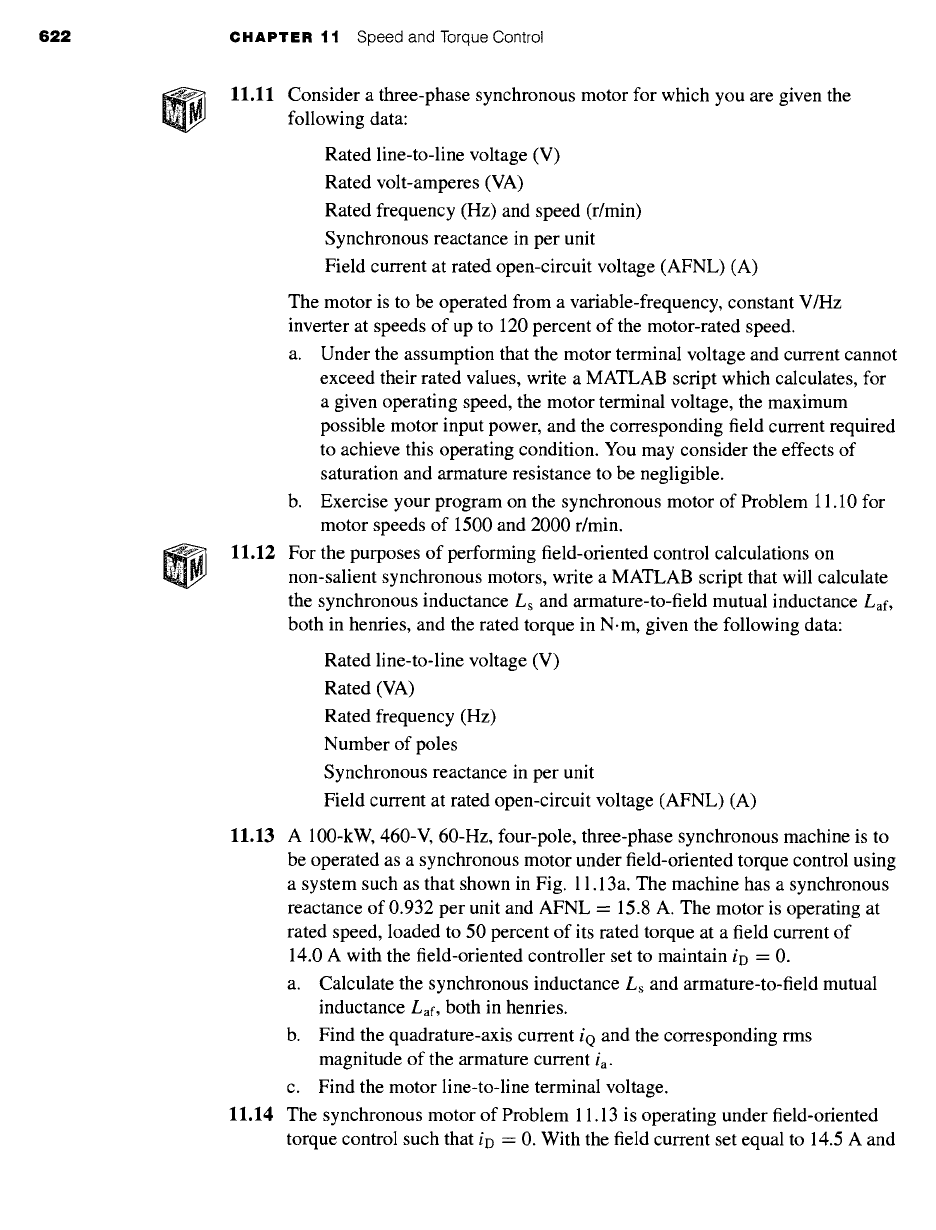
622 CHAPTER 11 Speed and Torque Control
11.11 Consider a three-phase synchronous motor for which you are given the
following data:
Rated line-to-line voltage (V)
Rated volt-amperes (VA)
Rated frequency (Hz) and speed (r/min)
Synchronous reactance in per unit
Field current at rated open-circuit voltage (AFNL) (A)
The motor is to be operated from a variable-frequency, constant V/Hz
inverter at speeds of up to 120 percent of the motor-rated speed.
a. Under the assumption that the motor terminal voltage and current cannot
exceed their rated values, write a MATLAB script which calculates, for
a given operating speed, the motor terminal voltage, the maximum
possible motor input power, and the corresponding field current required
to achieve this operating condition. You may consider the effects of
saturation and armature resistance to be negligible.
b. Exercise your program on the synchronous motor of Problem 11.10 for
motor speeds of 1500 and 2000 r/min.
11.12 For the purposes of performing field-oriented control calculations on
non-salient synchronous motors, write a MATLAB script that will calculate
the synchronous inductance Ls and armature-to-field mutual inductance
Laf,
both in henries, and the rated torque in N.m, given the following data:
Rated line-to-line voltage (V)
Rated (VA)
Rated frequency (Hz)
Number of poles
Synchronous reactance in per unit
Field current at rated open-circuit voltage (AFNL) (A)
11.13 A 100-kW, 460-V, 60-Hz, four-pole, three-phase synchronous machine is to
be operated as a synchronous motor under field-oriented torque control using
a system such as that shown in Fig. 11.13a. The machine has a synchronous
reactance of 0.932 per unit and AFNL -- 15.8 A. The motor is operating at
rated speed, loaded to 50 percent of its rated torque at a field current of
14.0 A with the field-oriented controller set to maintain iD = 0.
a. Calculate the synchronous inductance Ls and armature-to-field mutual
inductance
Laf,
both in henries.
b. Find the quadrature-axis
current iQ
and the corresponding rms
magnitude of the armature current ia.
c. Find the motor line-to-line terminal voltage.
11.14 The synchronous motor of Problem 11.13 is operating under field-oriented
torque control such that iD -- 0. With the field current set equal to 14.5 A and
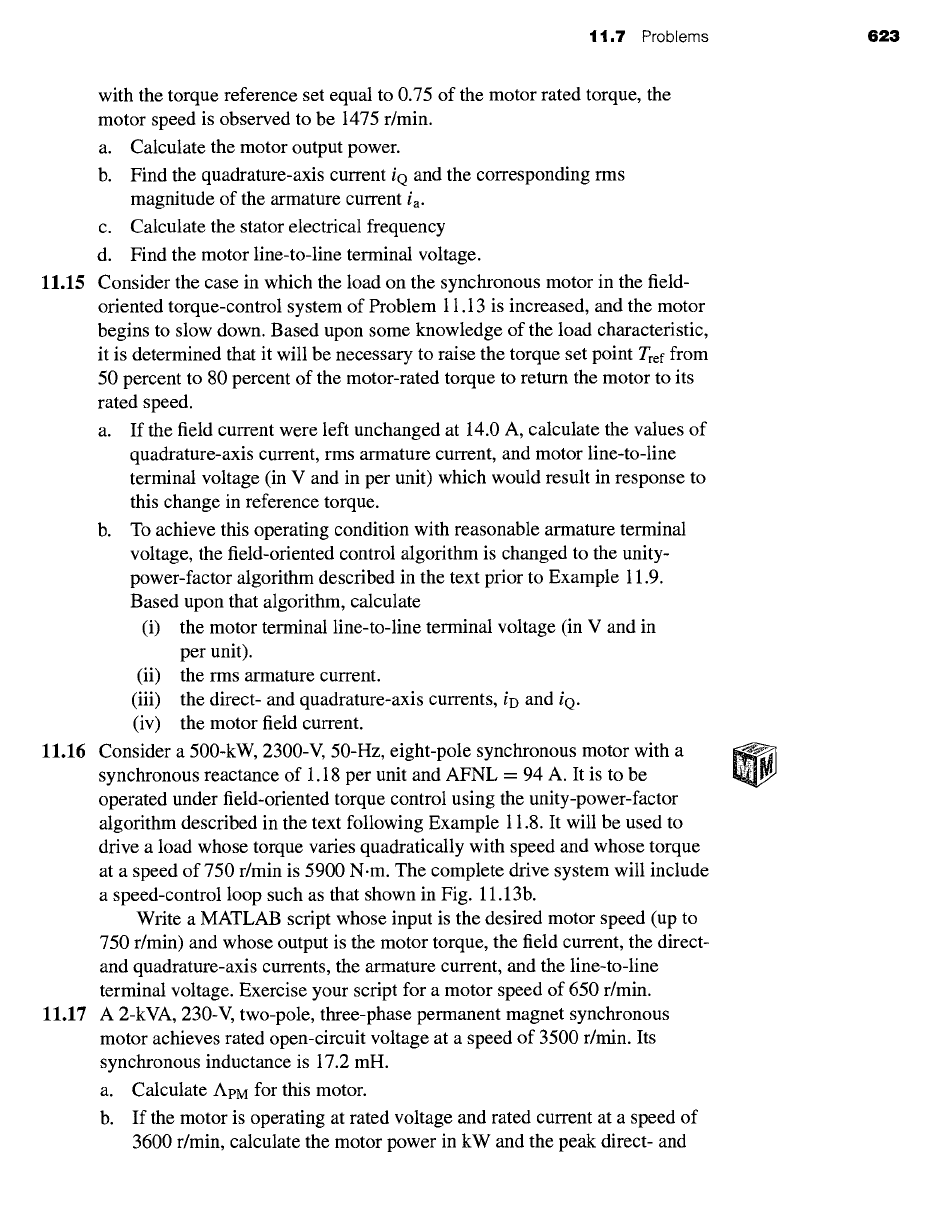
11.7 Problems
623
with the torque reference set equal to 0.75 of the motor rated torque, the
motor speed is observed to be 1475 r/min.
a. Calculate the motor output power.
b. Find the quadrature-axis current iQ and the corresponding rms
magnitude of the armature current ia.
c. Calculate the stator electrical frequency
d. Find the motor line-to-line terminal voltage.
11.15 Consider the case in which the load on the synchronous motor in the field-
oriented torque-control system of Problem 11.13 is increased, and the motor
begins to slow down. Based upon some knowledge of the load characteristic,
it is determined that it will be necessary to raise the torque set point
Tre f
from
50 percent to 80 percent of the motor-rated torque to return the motor to its
rated speed.
a. If the field current were left unchanged at 14.0 A, calculate the values of
quadrature-axis current, rms armature current, and motor line-to-line
terminal voltage (in V and in per unit) which would result in response to
this change in reference torque.
b. To achieve this operating condition with reasonable armature terminal
voltage, the field-oriented control algorithm is changed to the unity-
power-factor algorithm described in the text prior to Example 11.9.
Based upon that algorithm, calculate
(i) the motor terminal line-to-line terminal voltage (in V and in
per unit).
(ii) the rms armature current.
(iii) the direct- and quadrature-axis currents, iD and
iQ.
(iv) the motor field current.
11.16 Consider a 500-kW, 2300-V, 50-Hz, eight-pole synchronous motor with a
synchronous reactance of 1.18 per unit and AFNL = 94 A. It is to be
operated under field-oriented torque control using the unity-power-factor
algorithm described in the text following Example 11.8. It will be used to
drive a load whose torque varies quadratically with speed and whose torque
at a speed of 750 r/min is 5900 N.m. The complete drive system will include
a speed-control loop such as that shown in Fig. 11.13b.
Write a MATLAB script whose input is the desired motor speed (up to
750 r/min) and whose output is the motor torque, the field current, the direct-
and quadrature-axis currents, the armature current, and the line-to-line
terminal voltage. Exercise your script for a motor speed of 650 r/min.
11.17 A 2-kVA, 230-V, two-pole, three-phase permanent magnet synchronous
motor achieves rated open-circuit voltage at a speed of 3500 r/min. Its
synchronous inductance is 17.2 mH.
a. Calculate ApM for this motor.
b. If the motor is operating at rated voltage and rated current at a speed of
3600 r/min, calculate the motor power in kW and the peak direct- and
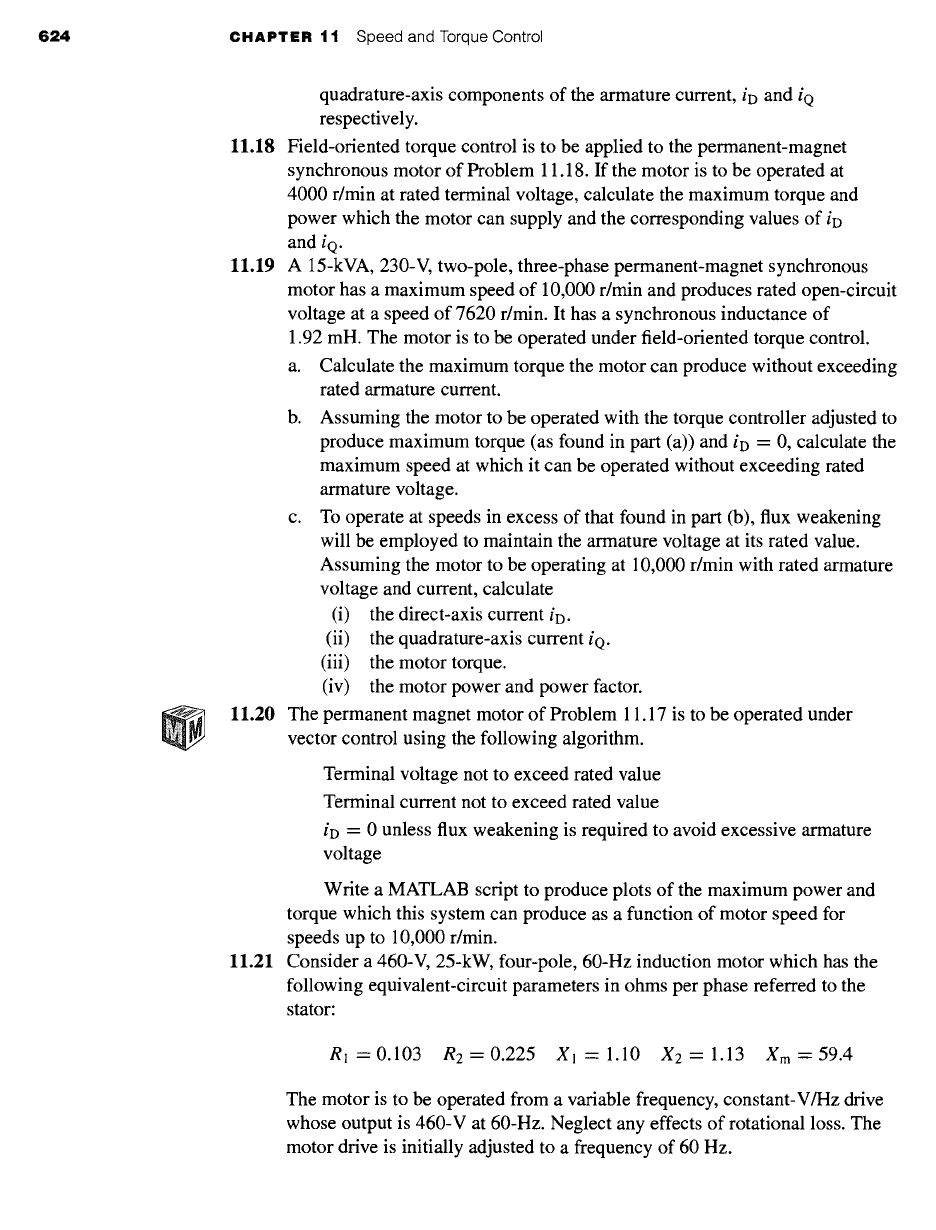
624 CHAPTER
11 Speed and Torque Control
quadrature-axis components of the armature current,
iD
and
iQ
respectively.
11.18 Field-oriented torque control is to be applied to the permanent-magnet
synchronous motor of Problem 11.18. If the motor is to be operated at
4000 ffmin at rated terminal voltage, calculate the maximum torque and
power which the motor can supply and the corresponding values of iD
and
iQ.
11.19 A 15-kVA, 230-V, two-pole, three-phase permanent-magnet synchronous
motor has a maximum speed of 10,000 ffmin and produces rated open-circuit
voltage at a speed of 7620 ffmin. It has a synchronous inductance of
1.92 mH. The motor is to be operated under field-oriented torque control.
a. Calculate the maximum torque the motor can produce without exceeding
rated armature current.
b. Assuming the motor to be operated with the torque controller adjusted to
produce maximum torque (as found in part (a)) and iD = 0, calculate the
maximum speed at which it can be operated without exceeding rated
armature voltage.
c. To operate at speeds in excess of that found in part (b), flux weakening
will be employed to maintain the armature voltage at its rated value.
Assuming the motor to be operating at 10,000 ffmin with rated armature
voltage and current, calculate
(i) the direct-axis current iD.
(ii) the quadrature-axis current io.
(iii) the motor torque.
(iv) the motor power and power factor.
11.20 The permanent magnet motor of Problem 11.17 is to be operated under
vector control using the following algorithm.
Terminal voltage not to exceed rated value
Terminal current not to exceed rated value
iD = 0 unless flux weakening is required to avoid excessive armature
voltage
Write a MATLAB script to produce plots of the maximum power and
torque which this system can produce as a function of motor speed for
speeds up to 10,000 r/min.
11.21 Consider a 460-V, 25-kW, four-pole, 60-Hz induction motor which has the
following equivalent-circuit parameters in ohms per phase referred to the
stator:
R] = 0.103
R2 =
0.225 X! = 1.10
X 2 =
1.13
X m =
59.4
The motor is to be operated from a variable frequency, constant-V/Hz drive
whose output is 460-V at 60-Hz. Neglect any effects of rotational loss. The
motor drive is initially adjusted to a frequency of 60 Hz.
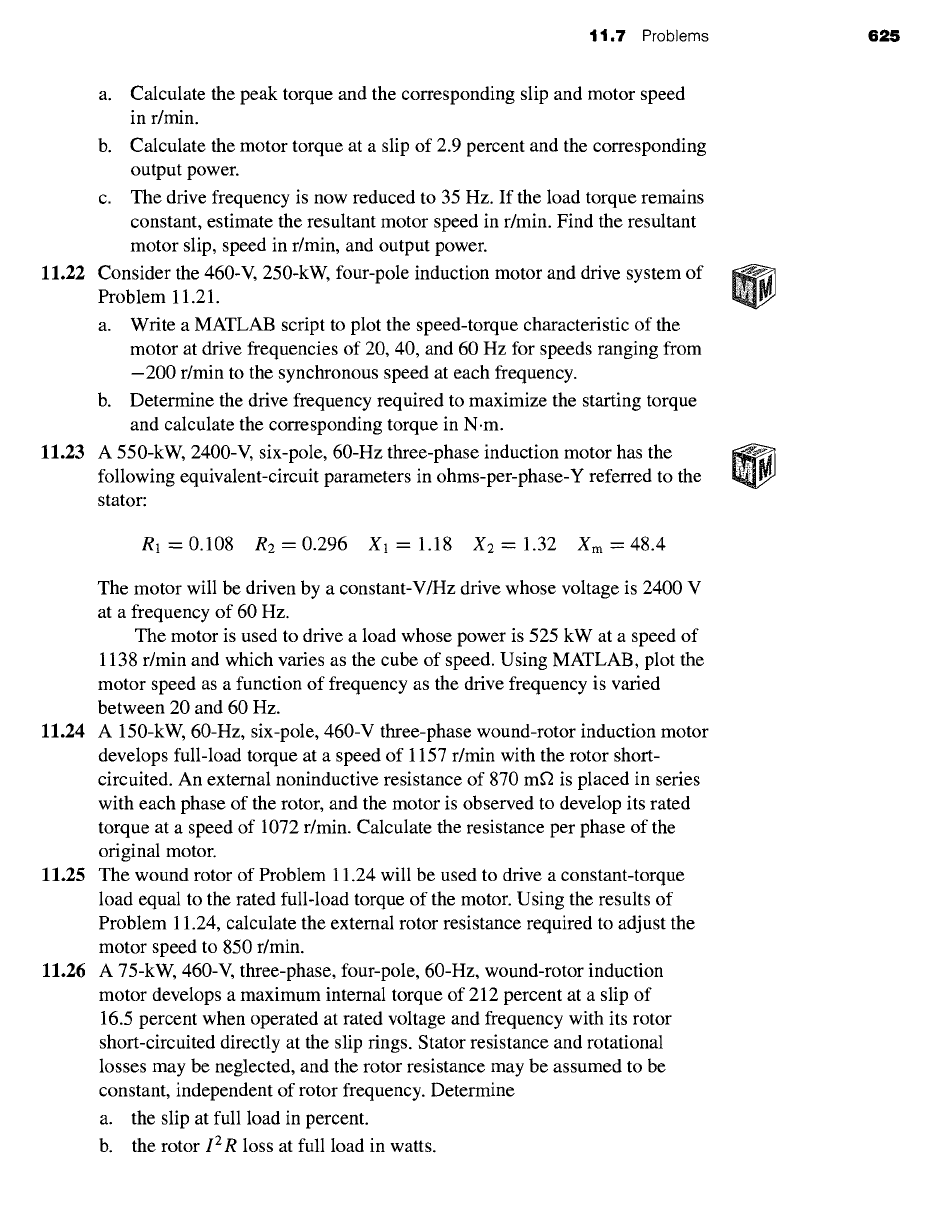
11.7 Problems 625
a. Calculate the peak torque and the corresponding slip and motor speed
in r/min.
b. Calculate the motor torque at a slip of 2.9 percent and the corresponding
output power.
c. The drive frequency is now reduced to 35 Hz. If the load torque remains
constant, estimate the resultant motor speed in r/min. Find the resultant
motor slip, speed in r/min, and output power.
11.22 Consider the 460-V, 250-kW, four-pole induction motor and drive system of
Problem 11.21.
a. Write a MATLAB script to plot the speed-torque characteristic of the
motor at drive frequencies of 20, 40, and 60 Hz for speeds ranging from
-200 r/min to the synchronous speed at each frequency.
b. Determine the drive frequency required to maximize the starting torque
and calculate the corresponding torque in N.m.
11.23 A 550-kW, 2400-V, six-pole, 60-Hz three-phase induction motor has the
following equivalent-circuit parameters in ohms-per-phase-Y referred to the
stator:
R1 = 0.108
R2 =
0.296 X1 = 1.18 X2 = 1.32
Xm =
48.4
The motor will be driven by a constant-V/Hz drive whose voltage is 2400 V
at a frequency of 60 Hz.
The motor is used to drive a load whose power is 525 kW at a speed of
1138 r/min and which varies as the cube of speed. Using MATLAB, plot the
motor speed as a function of frequency as the drive frequency is varied
between 20 and 60 Hz.
11.24 A 150-kW, 60-Hz, six-pole, 460-V three-phase wound-rotor induction motor
develops full-load torque at a speed of 1157 r/min with the rotor short-
circuited. An external noninductive resistance of 870 mr2 is placed in series
with each phase of the rotor, and the motor is observed to develop its rated
torque at a speed of 1072 r/min. Calculate the resistance per phase of the
original motor.
11.25 The wound rotor of Problem 11.24 will be used to drive a constant-torque
load equal to the rated full-load torque of the motor. Using the results of
Problem 11.24, calculate the external rotor resistance required to adjust the
motor speed to 850 r/min.
11.26 A 75-kW, 460-V, three-phase, four-pole, 60-Hz, wound-rotor induction
motor develops a maximum internal torque of 212 percent at a slip of
16.5 percent when operated at rated voltage and frequency with its rotor
short-circuited directly at the slip tings. Stator resistance and rotational
losses may be neglected, and the rotor resistance may be assumed to be
constant, independent of rotor frequency. Determine
a. the slip at full load in percent.
b. the rotor
I2R
loss at full load in watts.
